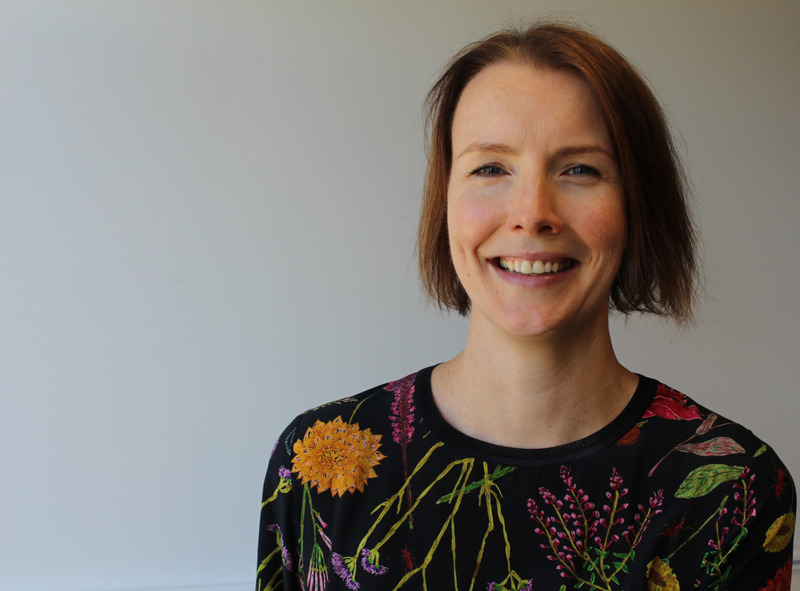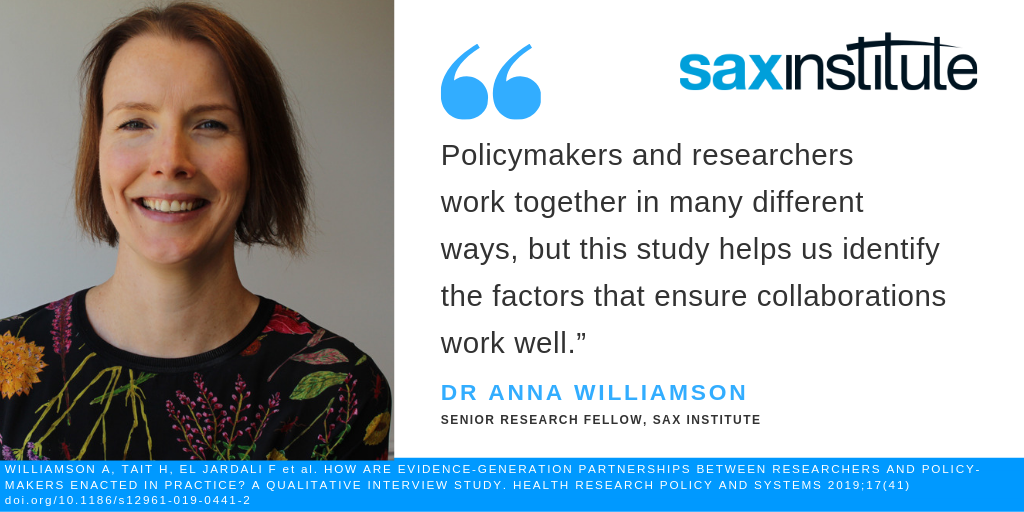
The past decade has seen an upsurge of interest in the ways that researchers can partner with policy agencies to help them craft more effective public health policies. Although these partnerships are one of the keys to ensuring that policy is underpinned by research evidence, they are often difficult to realise.
Dr Anna Williamson, Senior Research Fellow at the Sax Institute, is the lead author of two important new papers on this subject. One is a qualitative study based on in-depth interviews with policy makers and researchers, while the other looks at the lessons we can learn from the way research was used in 131 health policy documents. Dr Williamson sat down with Evidence Matters to talk about how public health researchers and policy makers can work best together.

Q: What key insights emerged from the interviews you conducted with researchers and policy makers?
A: One critical thing we learned was just how central the policy maker role in collaborations is for doing research that is likely to have an impact. It’s the policy makers who know what kind of evidence is needed in practice and how to drive its use. There can be quite a gap between what researchers think is interesting and what’s actually used in the real world.
Another thing that became clear from our interviews was that while co-producing research (where every element of the research process is conducted in partnership) is seen to have great value in some circumstances, it really requires a major time commitment on all sides to build and maintain the relationships required to do this kind of work well. A lot needs to be done to make sure researchers and policy makers are not speaking at cross purposes, and that everyone really does understand what the goal is and what the processes will be in achieving that and stays engaged throughout the research process. Because this is so labour-intensive, it might not necessarily be the right approach for every study. If you’re just doing a cross-sectional survey or analysis of existing data, that may not warrant the amount of time needed for true coproduction.
Q: What are the differences between projects initiated by researchers and those initiated by policy makers?
A: The big difference is where the power lies. When the project is initiated by a policy agency, they’re usually fully funding it and they will be more in control of setting the direction and determining what happens. Researchers are usually happy to do that kind of project, because it’s a good way of building relationships and gaining more knowledge about what’s happening on the ground. But they might find the work involved is not necessarily what they’re most interested in. Sometimes, they don’t get to use the most scientifically rigorous design, as these projects often need to be done quickly to fulfil an agency’s immediate need.
Researcher-initiated projects, on the other hand, are usually funded through peer-reviewed grants. That means the researchers tend to have more control, and it may be more exciting for them because they can use a more rigorous study design. Researchers have a bit more power in that dynamic, and perhaps as a result of that, the researchers that we talked to said the biggest challenge in partnering in those types of projects was that the agencies may not end up staying as engaged with the project.
My guess is that projects initiated by the policy agencies are the ones that are more likely to be used in policy, but that’s not something that we could conclusively determine from our work.
Q: You also looked at how evidence was used in over 130 public health policy documents. What did you learn from this study?
A: There’s been a lot of conceptual work around whether and how evidence is used in policy, but there haven’t been many studies that have actually looked at how it is used. That’s what we did in this study: we had interviews and documents related to 131 policy documents produced by six health policy agencies. So we were able to drill down and look statistically at what differences there were.
One of the interesting things to come out of our analysis was around barriers to using research evidence. A lot of barriers were named, but when we looked statistically, those barriers actually made no significant difference as to whether research was used. What really made the difference was the culture of using evidence at an agency, and that mostly depended on context and the type of work the agency was doing. So I think if you’re really trying to change the way evidence is used, a key aspect of that is changing culture and expectations.
On the other hand, we did find some facilitators to using research evidence. Having access to consultants who could help people synthesise research and developing relationships with researchers made a big difference as to how agencies engaged with evidence. It didn’t necessarily mean the evidence got used, because there are always a lot of factors other than evidence that influence policy making, but it meant the evidence was at least considered and I think that’s a positive.
Q: Are policy agencies truly invested in working with researchers, or does more need to be done?
A: There’s a desire in governments to use evidence in policy and there are increasing efforts to make that happen. That is certainly very evident in New South Wales where our studies took place. But it’s always going to be the case that policy is incredibly complex. Policy makers need to juggle so many economic, social and legislative issues, so research evidence is never going to be the primary consideration. Policy will only ever be evidence-informed, rather than evidence-based.
Q: What more can we do to promote the use of research in public health policy?
A: Here at the Sax Institute, we’re building new tools and models to help increase people’s skills and capacity to partner. We have an early career researcher course which we’ve started to evaluate and so far it is proving to be effective at increasing people’s skills and confidence around knowing how to initiate and sustain partnerships with policy agencies.
We’re also putting together a resource which contains lots of different tools to help with partnering. We’ve learned that partnerships often falter over quite practical matters, such as governance structure, or what has or hasn’t been agreed to in a contract. So we’re trying to put together some really practical resources to help people avoid these pitfalls. There’s still a lot to be done in terms of building new knowledge about helping people work better together because at the moment, the people who are good at it have learned the hard way through actually doing it, and there are not a lot of resources available.
You can access the latest studies by Dr Williamson and her colleagues here and here.
The Sax Institute runs courses for early career researchers on building successful partnerships for policy-relevant research: click here for more information.





